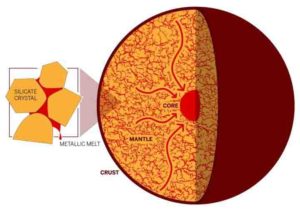
Scientists have long pondered how rocky bodies in the solar system — including our own Earth — got their metal cores. According to research conducted by The University of Texas at Austin, evidence points to the downwards percolation of molten metal toward the center of the planet through tiny channels between grains of rock.
The finding calls into question the interpretation of prior experiments and simulations that sought to understand how metals behave under intense heat and pressure when planets are forming. Past results suggested that large portions of molten metals stayed trapped in isolated pores between the grains. In contrast, the new research suggests that once those isolated pores grow large enough to connect, the molten metal starts to flow, and most of it is able to percolate along grain boundaries. This process would let metal trickle down through the mantle, accumulate in the center, and form a metal core, like the iron core at the heart of our home planet.
“What we’re saying is that once the melt network becomes connected, it stays connected until almost all of the metal is in the core,” said co-author Marc Hesse, an associate professor in the UT Jackson School of Geosciences Department of Geological Sciences, and a member of UT’s Institute for Computational Engineering and Sciences.
The research was published on Dec. 4 in the Proceedings of the National Academy of Sciences. The work was the doctoral thesis of Soheil Ghanbarzadeh, who earned his Ph.D. while a student in the UT Department of Petroleum and Geosystems Engineering (now the Hildebrand Department of Petroleum and Geosystems Engineering). He currently works as a reservoir engineer with BP America. Soheil was jointly advised by Hesse and Maša Prodanovic, an associate professor in the Hildebrand Department and a co-author.
Planets and planetesimals (small planets and large asteroids) are formed primarily from silicate rocks and metal. Part of the planet formation process involves the initial mass of material separating into a metallic core and a silicate shell made up of the mantle and the crust. For the percolation theory of core formation to work, the vast majority of metal in the planetary body must make its way to the center.
In this study, Ghanbarzadeh developed a computer model to simulate the distribution of molten iron between rock grains as porosity, or melt fraction, increased or decreased. The simulations were perfomed at the Texas Advanced Computing Center. Researchers found that once the metal starts to flow, it can continue flowing even as the melt fraction decreases significantly. This is in contrast to previous simulations that found that once the metal starts flowing, it only takes a small dip in the volume of melt for percolation to stop.
“People have assumed that you disconnect at the same melt fraction at which you initially connected…and it would leave significant amounts of the metal behind,” Hesse said. “What we found is that when the metallic melt connects and when it disconnects is not necessarily the same.”
According to the computer model, only 1 to 2 percent of the initial metal would be trapped in the silicate mantle when percolation stops, which is consistent with the amount of metal in the Earth’s mantle.
The researchers point to the arrangement of the rock grains to explain the differences in how well-connected the spaces between the grains are. Previous work used a geometric pattern of regular, identical grains, while this work relied on simulations using an irregular grain geometry, which is thought to more closely mirror real-life conditions. The geometry was generated using data from a polycrystalline titanium sample that was scanned using X-ray microtomography.
“The numerical model Soheil developed in his Ph.D. thesis allowed for finding three-dimensional melt networks of any geometrical complexity for the first time,” said Prodanovic. “Having a three-dimensional model is key in understanding and quantifying how melt trapping works.”
The effort paid off because researchers found that the geometry has a strong effect on melt connectivity. In the irregular grains, the melt channels vary in width, and the larges ones remain connected even as most of the metal drains away.
“What we did differently in here was to add the element of curiosity to see what happens when you drain the melt from the porous, ductile rock,” said Ghanbarzadeh.
The researchers also compared their results to a metallic melt network preserved in an anchondrite meteorite, a type of meteorite that came from a planetary body that differentiated into discernable layers. X-ray images of the meteorite taken in the Jackson School’s High-Resolution X-Ray CT Facility revealed a metal distribution that is comparable to the computed melt networks. Prodanovic said that this comparison shows that their simulation capture the features observed in the meteorite.
The study was funded by the Statoil Fellows Program at UT Austin and the National Science Foundation.
Reference:
Soheil Ghanbarzadeh, Marc A. Hesse, Maša Prodanović. Percolative core formation in planetesimals enabled by hysteresis in metal connectivity. Proceedings of the National Academy of Sciences, 2017; 201707580 DOI: 10.1073/pnas.1707580114
Note: The above post is reprinted from materials provided by University of Texas at Austin.










